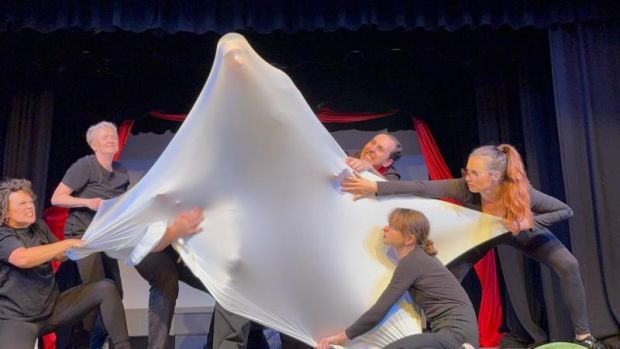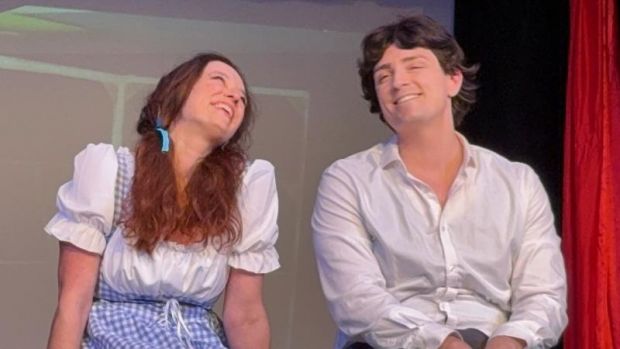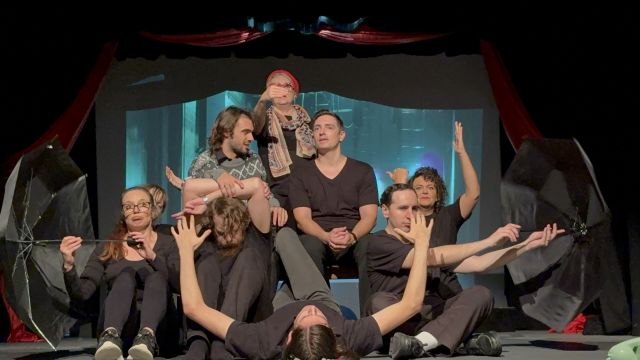Holding the Man
Tommy Murphy’s sensitive adaptation of Timothy Conigrave’s deeply personal memoir of his relationship with John Caleo places their story securely in its time yet also transcends time and place. It tells a love story that, in the words of director John Forbes is “uniquely theirs, yet deeply universal” – one that reaches across boundaries and generations.
Forbes handling of this delicate play is deft and respectful. It is a touchingly moving production that portrays the beauty and challenges of Conigrave and Caleo’s relationship. The play that uses a clever combination of theatre styles and characterisation to tell a story that reminds its audiences of “the courage it takes to be truly seen” – and subtly defies it to judge.

Murphy creates the two boys clearly yet uses almost caricatures to depict their friends and families. It’s a very clever technique, and one that John Forbes and his cast use skilfully. The production begins with a theatrical “warm up” occurring as the audience enters, then going straight into the play as the lights fade. This sets an unusual atmosphere, taking the audience right ‘inside’ the production. They see the characters emerge – two of them always the same, others changing from scene to scene.
Dale Morgan-Mawby and Ashley Benson introduce Tim Conigrave and John Caleo, firstly as they meet as students at Xavier College. Both actors create the budding relationship with a gentle innocence that makes their characters very real and appealing. Their hesitancy, tentative reaching out, shy smiles and cautious touching could be any young relationship.

But it isn’t. It’s one that they will find isn’t generally accepted – and both actors take their characters through the beautiful highs and very complex – and fearful – lows of being different in an intolerant and judgemental society.
Morgan-Mawby finds the open, unguardedness of Conigrave, his unfeigned self-assurance, and his developing strength and integrity. He takes Conigrave from awkward teenager to university student to HIV activist to desperate, tender, caring lover in a performance that recreates the man who was able to share his love and grief in such an honest memoir.

Benson finds the shy, tentativeness of the teenage Caleo – and the difficulties of a family that rejected him. Benson makes Caleo warm, approachable but vulnerable to his father’s wrath. He takes Caleo from confident sportsman, aspiring student and gentle lover to a patient racked with the pain and fear of approaching death.
Benson’s last few minutes on the stage in Morgan-Mawby’s arms are heart-breakingly real, recreating the anguish – and horror – of the virus that cost so many lives in the last decades of last century.
Stories like Holding the Man ensure that it won’t be forgotten.

The supporting cast play the people that were important in the boys’ lives – trusting friends, supportive or uncompromising parents, another lover, clinical hospital staff, caring nurses. Murphy uses caricatures in the early scenes, perhaps to contrast the depth of the boys’ developing relationship with the superficiality of everyday life. This makes for interesting theatre, juxtaposing realism and symbolism, until, as the play proceeds and illness strikes, the parents become more real, the friends still faithful. The final scenes are harrowing for the now much more real and grieving parents.
Rebecca Dean, Naomi Crew, Gabriel Pope, Zak Harrison, Madeleine Sheehy, Joshua Stojanovic and Niamh Bonnet move from role to role with apparent ease, teenagers one scene, parents the next – and they dance as well! Because Tommy Murphy’s play has lovely touches of humour. Conigrave’s wry asides, a hilarious boys’ dorm scene, and some funny caricatures, all interwoven in the chapters of a love story that is, as Forbes suggests, “profoundly relatable” whether one is part of the LGBTQ+ community or not.
Forbes production is tight, the changes in pace and emotion carefully managed and sustained. Forbes and his cast have made this a “labour of love” – and that love shines through in every joyful – and heart-wrenching – moment.
Carol Wimmer
Subscribe to our E-Newsletter, buy our latest print edition or find a Performing Arts book at Book Nook.

